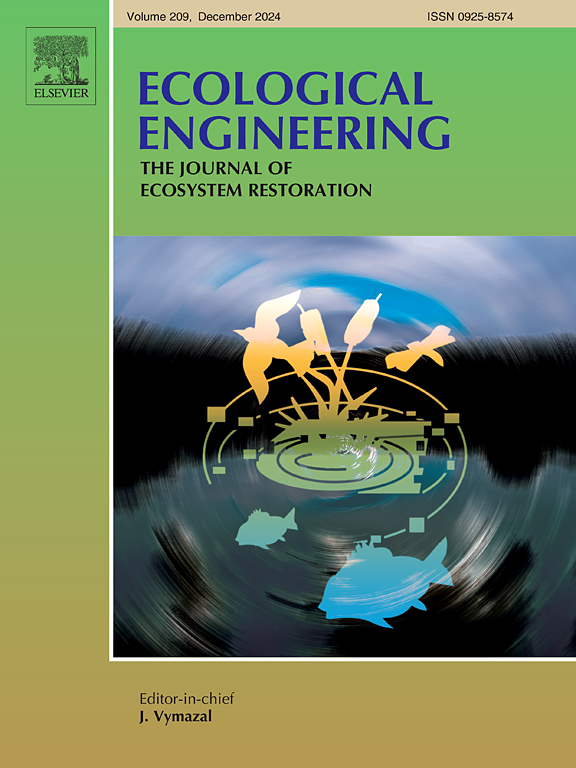Application of multi-electron donor autotrophic denitrification (MEDAD) substrate in constructed wetlands for treating low carbon-to‑nitrogen ratio wastewater: A feasible framework
IF 4.1
2区 环境科学与生态学
Q1 ECOLOGY
引用次数: 0
Abstract
Constructed wetlands (CWs) offer a sustainable solution for treating low carbon-to‑nitrogen (C/N) ratio wastewater, yet their nitrogen removal efficiency is often constrained by insufficient organic electron donors. This review systematically evaluates the mechanisms, efficacy, and challenges of autotrophic denitrification in CWs using inorganic electron donors, including sulfur-, iron-, hydrogen-, and manganese-based systems. Sulfur-based systems (e.g., S0, pyrite) achieve nitrate removal rates exceeding 90 % but risk sulfate accumulation and acidification, while iron-based substrates (e.g., siderite, steel slag) enhance simultaneous nitrogen (71 % TN removal) and phosphorus removal (93 % TP removal) via Fe2+/Fe3+ redox reactions. Hydrogenotrophic denitrification exhibits high efficiency (>97 % NO3−-N removal) but faces practical hurdles in H2 utilization. Crucially, multi-electron donor autotrophic denitrification (MEDAD) systems, integrating substrates like pyrite-steel slag composites, demonstrate synergistic benefits: TN and TP removal efficiencies improve by 40–54 % and 19 %, respectively, while stabilizing pH and mitigating phytotoxicity. The interplay between wetland vegetation and MEDAD substrates is highlighted, with root exudates (e.g., organic acids, sugars) potentially regulating microbial denitrification pathways. However, challenges persist, including byproduct management (e.g., sulfates, Fe (OH)3 passivation), substrate longevity, and scalability. This study proposes a feasibility framework for MEDAD-CW integration, emphasizing substrate optimization, microbial community control, and system engineering. By addressing these factors, MEDAD-CWs can achieve efficient, stable treatment of low C/N ratio wastewater, advancing their application in eutrophication mitigation and water quality restoration.

多电子供体自养反硝化(MEDAD)底物在人工湿地处理低碳氮比废水中的应用:一个可行的框架
人工湿地(CWs)为处理低碳氮比(C/N)废水提供了一种可持续的解决方案,但其除氮效率往往受到有机电子供体不足的限制。本文系统地评估了无机电子供体(包括硫基、铁基、氢基和锰基系统)在化学武器中自养反硝化的机制、效果和挑战。硫基系统(如硫、黄铁矿)的硝酸盐去除率超过90%,但存在硫酸盐积累和酸化的风险,而铁基底物(如黄铁矿、钢渣)通过Fe2+/Fe3+氧化还原反应,同时提高了氮(去除71%的TN)和磷(去除93%的TP)的去除率。氢化反硝化具有很高的效率(去除率达97%),但在H2利用方面面临实际障碍。重要的是,多电子供体自养反硝化(MEDAD)系统整合了黄铁矿-钢渣复合材料等底物,显示出协同效益:TN和TP的去除效率分别提高了40 - 54%和19%,同时稳定了pH值并减轻了植物毒性。强调了湿地植被与MEDAD基质之间的相互作用,根分泌物(例如有机酸,糖)可能调节微生物反硝化途径。然而,挑战依然存在,包括副产品管理(例如硫酸盐、Fe (OH)3钝化)、衬底寿命和可扩展性。本研究提出了MEDAD-CW整合的可行性框架,强调底物优化、微生物群落控制和系统工程。通过解决这些因素,MEDAD-CWs可以高效、稳定地处理低碳氮比废水,推进其在富营养化缓解和水质恢复中的应用。
本文章由计算机程序翻译,如有差异,请以英文原文为准。
求助全文
约1分钟内获得全文
求助全文
来源期刊

Ecological Engineering
环境科学-工程:环境
CiteScore
8.00
自引率
5.30%
发文量
293
审稿时长
57 days
期刊介绍:
Ecological engineering has been defined as the design of ecosystems for the mutual benefit of humans and nature. The journal is meant for ecologists who, because of their research interests or occupation, are involved in designing, monitoring, or restoring ecosystems, and can serve as a bridge between ecologists and engineers.
Specific topics covered in the journal include: habitat reconstruction; ecotechnology; synthetic ecology; bioengineering; restoration ecology; ecology conservation; ecosystem rehabilitation; stream and river restoration; reclamation ecology; non-renewable resource conservation. Descriptions of specific applications of ecological engineering are acceptable only when situated within context of adding novelty to current research and emphasizing ecosystem restoration. We do not accept purely descriptive reports on ecosystem structures (such as vegetation surveys), purely physical assessment of materials that can be used for ecological restoration, small-model studies carried out in the laboratory or greenhouse with artificial (waste)water or crop studies, or case studies on conventional wastewater treatment and eutrophication that do not offer an ecosystem restoration approach within the paper.
 求助内容:
求助内容: 应助结果提醒方式:
应助结果提醒方式:


